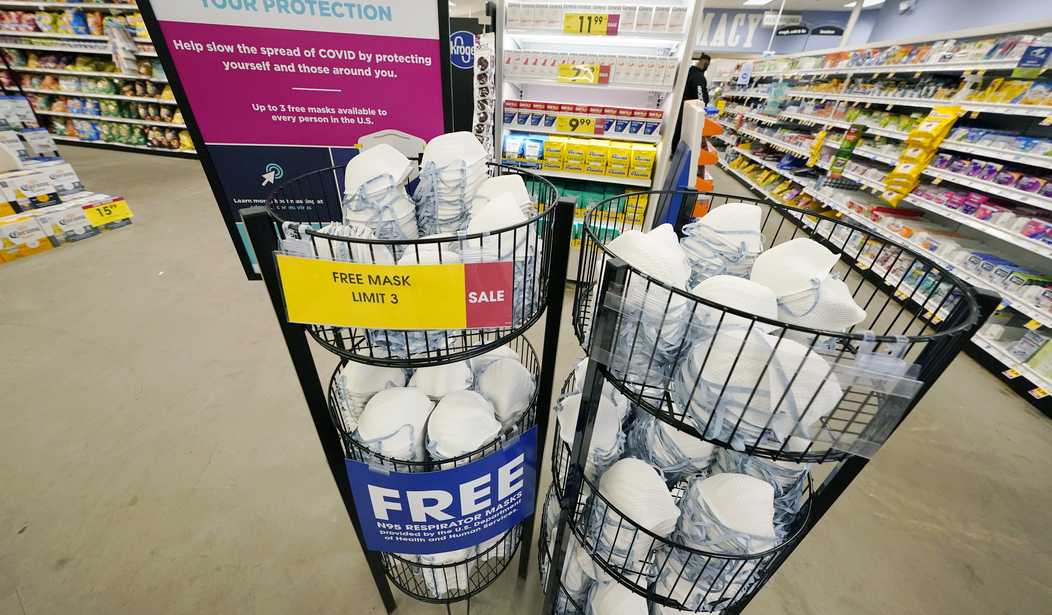Do masks prevent transmission of COVID-19? Yes, reports the New York Times’ David Leonhardt — in the laboratory. In the real world, no data definitively establishes effectiveness of masking, and especially of mask mandates. The difference matters, Leonhardt warns, because upticks in transmission and hospitalization will likely have policymakers reverting back to mask mandates even though there is no data that shows an impact on either:
Masks reduce the spread of the Covid virus by preventing virus particles from traveling from one person’s nose or mouth into the air and infecting another person. Laboratory studies have repeatedly demonstrated the effect.
Given this, you would think that communities where mask-wearing has been more common would have had many fewer Covid infections. But that hasn’t been the case.
In U.S. cities where mask use has been more common, Covid has spread at a similar rate as in mask-resistant cities. Mask mandates in schools also seem to have done little to reduce the spread. Hong Kong, despite almost universal mask-wearing, recently endured one of the world’s worst Covid outbreaks.
Advocates of mandates sometimes argue that they do have a big effect even if it is not evident in population-wide data, because of how many other factors are at play. But this argument seems unpersuasive.
Not only is the argument unpersuasive, it argues against clearly demonstrated effects from other strategies. Most notably, vaccination rates have a clear and consistent impact on deaths and severely acute cases, a trend which started obviously when vaccines became widely available. But even after the majority of the population had been vaccinated — and more exposed — mask mandates didn’t show any significant impact:
After all, the effect of vaccines on severe illness is blazingly obvious in the geographic data: Places with higher vaccination rates have suffered many fewer Covid deaths. The patterns are clear even though the world is a messy place, with many factors other than vaccines influencing Covid death rates.
Yet when you look at the data on mask-wearing — both before vaccines were available and after, as well as both in the U.S. and abroad — you struggle to see any patterns.
Even the idea that hospitalizations are ticking up is somewhat suspect. The CDC still does not distinguish between COVID-correlated admissions and deaths and COVID-caused admissions and deaths. Four months ago, the CDC belatedly announced an effort to refine reporting systems to distinguish between the two, but they still lump both together. That’s an even bigger problem than two years ago, thanks to variants which are much less likely to produce seriously acute COVID-19 cases.
Even with these cases likely being mostly correlative, the bump upward in admissions is still fairly small in the context of wildly transmissible variants:

The seven-day average for daily admissions correlated to a COVID-19 diagnoses is 3,682. Four months ago it was 21,407, and since most of those weren’t severe, it didn’t create a resource crisis at that time. Correlated deaths are not spiking upward at the moment by any significant amount either. The chart that Leonhardt includes shows almost no change in correlated ICU cases either, which means that we’re not stressing our resources unduly, to the extent that these cases involve actual causative admissions rather than admissions of people for other reasons that have also been exposed to the current COVID variants.
Leonhardt argues correctly, however, that there is no rational basis for imposing any more mask mandates no matter what the transmission levels might be. We have access to much more effective measures, including vaccines and therapeutics with evidence of significant impact. If people choose to wear masks, he points out, there is also evidence of effectiveness in one-way masking — as long as one wears effective masks, which most people have eschewed for useless cloth masks and only marginally effective disposable paper masks.
Finally, we should demand better data before any more intrusive interventions get imposed. The CDC has had plenty of time to distinguish between correlative and causative data, and their failure to close that basic gap in public data is a powerful indictment of their own expertise in managing this pandemic and others.








Join the conversation as a VIP Member